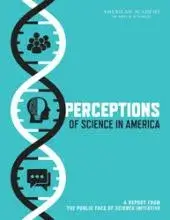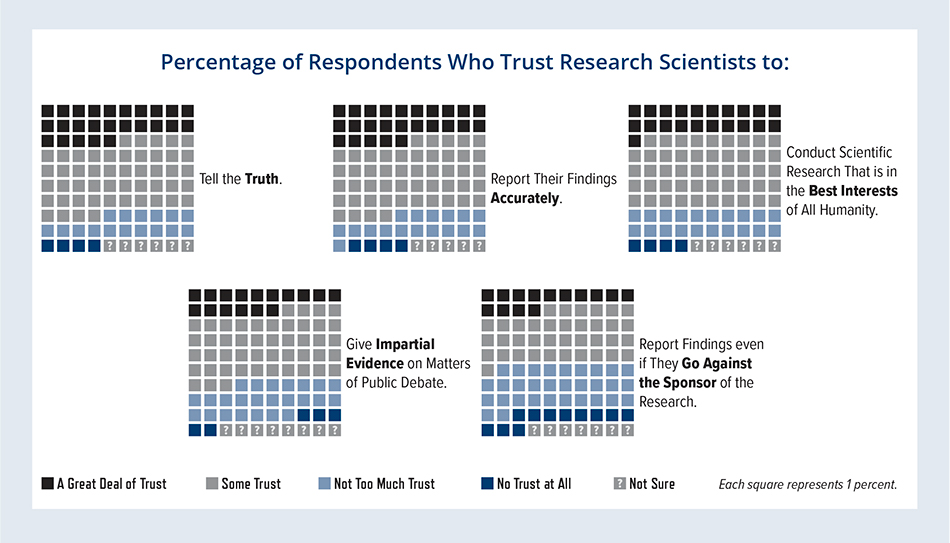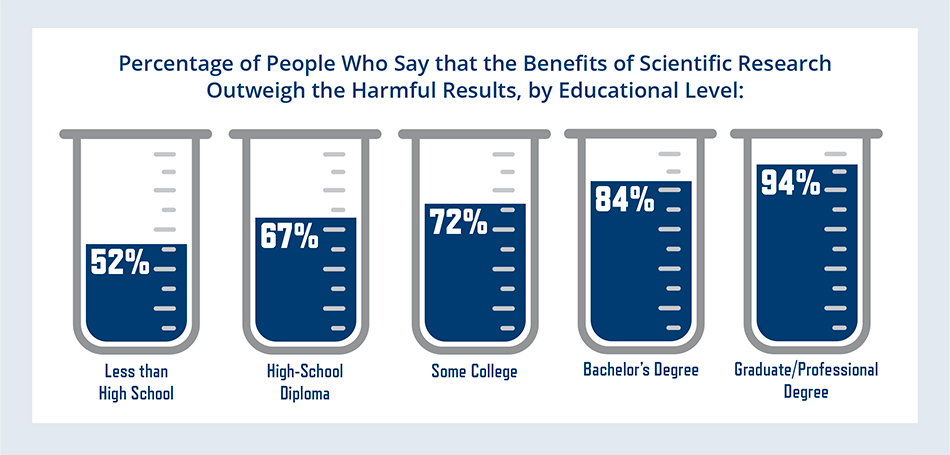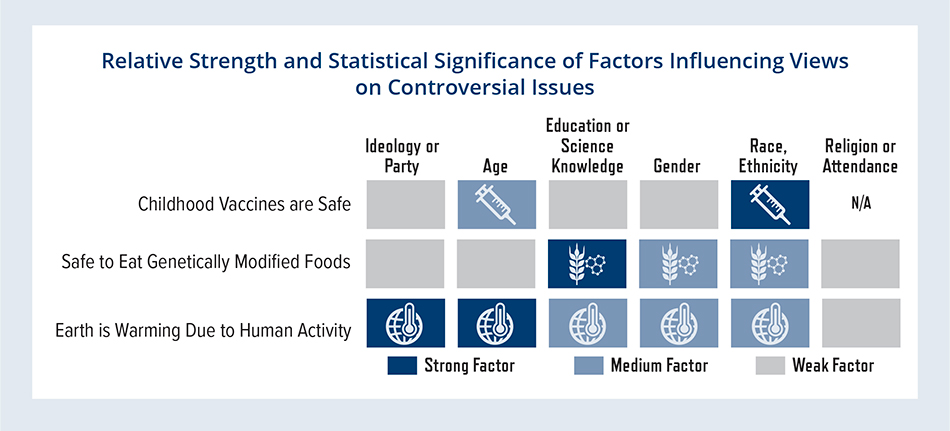The American Academy’s effort to understand the complex and evolving relationship between scientists and the public is beginning its third year. The project has brought together representatives from a number of different fields – including social scientists, scholars of science communication, representatives from science centers, and science communicators – to examine public perceptions of science and how the public encounters and engages with science in its everyday life. In the first two years of the project, the Academy has hosted two workshops and ten roundtables to gather feedback from Academy Members and content experts that will shape the project’s final reports.

In February, the Academy published the first in a series of reports that will be released in the coming year. Perceptions of Science in America offers an in-depth examination of the current state of trust in science among Americans. The data paint a picture of a heterogeneous public whose perceptions are dependent on context and values. The report underscores the need for additional studies on the influences on attitudes toward science, as well as how those attitudes impact both personal decisions and public support for evidence-based policy. Since its release, Perceptions of Science in America has already been used in classrooms and in science communication trainings.
Over the next year, the forthcoming project reports will seek to build on the discussion Perceptions of Science in America started among science communicators, advocates, and researchers. The second report focuses on informal science engagement and information sources, including news outlets, museums, and social media. The report will use a mix of quantitative data, research studies, and anecdotes to discuss science engagement online, at informal science venues, and in art and literature. The goal is to develop a resource on the topic of science engagement for practitioners, researchers, and funders. The final report will focus on improving the practice of science communication and engagement, drawing on ideas generated during project workshop discussions in June 2017.
In addition to these three major project publications, the Public Face of Science project has recently commissioned a study comparing public values of science around the world. This report will include a correlative analysis of the effect of country-specific indicators, such as economic development, level of democratic freedom, and degree of inequality on attitudes toward science. Copies of reports may be requested by emailing sciencepolicy@amacad.org.
The Academy gratefully acknowledges support from the Gordon and Betty Moore Foundation, the Rita Allen Foundation, the Alfred P. Sloan Foundation, and the Hellman Fellows Fund.
In a recent Scientific American Observations essay “The Complex Interface between the Public and Science,” Cary Funk, Director of Science and Society Research at the Pew Research Center and a data advisor to the Public Face of Science initiative, highlights the top three takeaways of the Perceptions of Science in America report. The essay is reprinted below with permission.
There’s a new resource in town for science advocates, communicators, researchers and others with an interest in understanding what the public thinks about science. The compendium from the American Academy of Arts and Sciences pulls together data from public opinion surveys on public trust in science and scientists to highlight three key points that are often forgotten or misunderstood.
First, in contrast to views of other institutions, public confidence in scientific leaders has remained stable since the 1970s, according to data from the General Social Survey conducted by the NORC at the University of Chicago. But the breadth of the scientific enterprise and the lack of consensus about the boundaries of science often lead to a more complicated portrait of public opinion. For example, an exploratory market research survey from ScienceCounts, a non-profit aiming to enhance public support for federally funded scientific research, finds a sizeable minority of the public (42 percent) has no trust or not too much trust that scientists will report findings even if the findings go against the sponsor of the research.

Source: ScienceCounts, unpublished data from “Raising Voices for Science: Exploratory and Benchmarking Survey” (survey conducted October 2015).
Second, time and again in surveys, there are important differences among subgroups of the public in the degree to which they trust science and support scientific research. The scientific community would do well to remember that “the public” is not monolithic – age, race and ethnicity, political viewpoints and levels of education influence people’s opinions. Just one example from the 2016 General Social Survey conducted on behalf of the National Science Board, fully 94 percent of Americans with a postgraduate degree think the benefits of scientific research outweigh the harmful results compared with about half (52 percent) of those who have not completed high school.

Source: National Science Board, Science & Engineering Indicators (2018).
Third, there is no single “anti-science” demographic group. While more research is needed to better understand what drives skepticism among some in the public about scientific evidence or scientific consensus, past studies have shown no single background factor such as politics, education, age, race/ethnicity, gender or region consistently predicts who among the public is more skeptical of prevailing scientific consensus.

Source: Cary Funk and Lee Rainie, Americans, Politics and Science Issues, Pew Research Center (July 1, 2015; survey conducted August 2014).
On climate and energy issues, people’s views are strongly connected with their political identities but views about the measles, mumps and rubella vaccine and eating genetically modified foods are not, according to Pew Research Center studies. And people’s group identities – whether rooted in politics or some other identity – can influence how people integrate knowledge and understanding about science into their beliefs. The next generation of research on these topics hopes to better understand how and why this occurs.
The American Academy embarked on this report with a stellar steering committee and a range of advisers to address what they describe as the “complex and evolving relationship between scientists and the public.” The Academy plans to delve into how people encounter science in their daily lives and offer recommendations for science communication and engagement down the road. Until then, Perceptions of Science in America offers a rare synthesis of current understanding about public perceptions of science as well as the gaps in that understanding.
One thing is already clear from this roadmap. Those wishing to better grasp public thinking about science need to look beyond trust in “science” writ large to see how people make sense of the science issues and domains which connect with their lives – such as childhood vaccines, genetically modified foods, and climate change – and think beyond one “public” to the reasons for pockets of support and resistance to scientific evidence among the populace.
Reprinted with permission. “The Complex Interface between the Public and Science,” Pew Research Center, Washington, DC (February 26, 2018).